Asus Dual RTX 2060 Super O8G-EVO Review
Asus Dual RTX 2060 Super O8G-EVO Review
Great Quad HD graphics card with added ray tracing
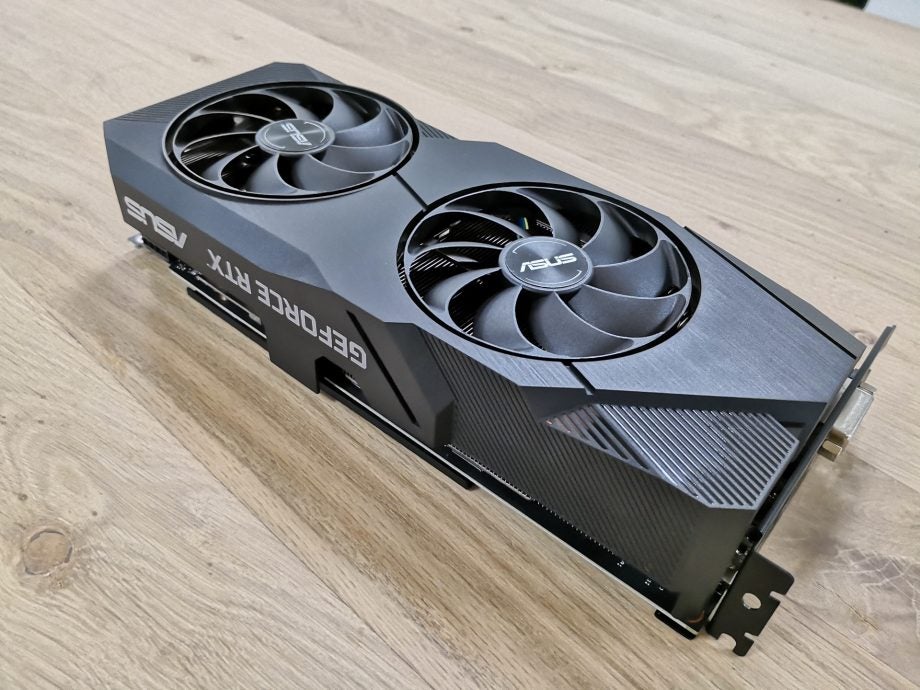
Verdict
The RTX 2060 Super isn’t quite the bargain as its non-super equivalent or AMD’s Radeon RX 5700, but still offers an excellent Quad HD performance as well as the exciting ray tracing technology.
Pros
- Great Quad HD performance
- Future-proofed for ray tracing support
- Decent overclocking potential
Cons
- Cheaper RX 5700 offers superior performance
- Few games support ray tracing and DLSS
Key Specifications
- Review Price: £453
- Real-time ray tracing support
- Base clock: 1500MHz
- 8-pin PCIe connection
- Boost clock: 1725MHz
- 8GB GDDR6
- 2 x HDMI 2.0b, 2 x DisplayPort 1.4, 1 x DVI-D
What is the Asus Dual RTX 2060 Super O8G-EVO?
The Asus Dual RTX 2060 Super O8G-EVO is Asus’s third-party version of Nvidia’s RTX 2060 Super, an upgraded edition of the original RTX 2060.
Coming in the wake of AMD’s new Radeon RX 5700 and Radeon RX 5700 TX, the new RTX 2060 Super very much feels like a reaction from Nvidia, possibly spooked by the excellent value the new Navi-based graphics processors offer.
The new RTX 2060 Super should offer performance that not only supersedes the previous RTX 2060 from six months ago, but also sees off the fresh challenge from AMD.
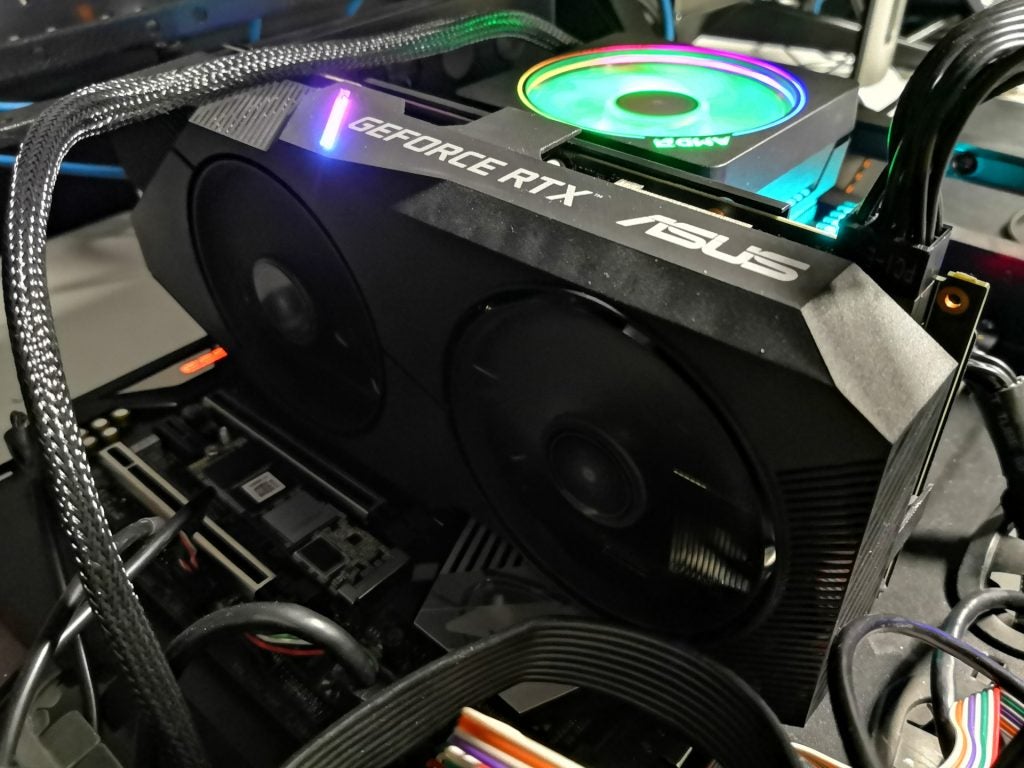
The Asus Dual RTX 2060 Super O8G-EVO is an incredibly large graphics card, so it might not be the best fit for small cases
While the only version we’ve been able to get our mitts on so far is the Asus Dual RTX 2060 Super O8G-EVO, it shares the same design and many of the core specs announced by Nvidia, and supports Nvidia’s current trump card feature – real-time ray tracing.
Of course, be aware the Asus Dual RTX 2060 Super O8G-EVO is more powerful and more expensive than the Founders Edition RTX 2060 Super, so don’t take this review as a complete reflection on Nvidia’s own vanilla version.
Related: Best graphics card
Asus Dual RTX 2060 Super O8G-EVO – Design, specifications and technology
What are the main differences between the ready salted RTX 2060 from earlier in the year, and the newer generation of RTX 2060 Super cards?
On paper, very little. Below is a quick table with the basic specs of the Founders Edition RTX 2060 we reviewed earlier in the year, reference spec for RTX 2060 Super cards from Nvidia, and the official specs of the Asus Dual RTX 2060 Super O8G-EVO. We also included the specs for the new AMD Radeon RX 5700:
| RTX 2060 Super Founders Edition | Asus Dual RTX 2060 Super O8G-EVO | RTX 2060 Founders Edition | AMD Radeon RX 5700 | |
| Architecture | Turing | Turing | Turing | Navi |
| Base clock speed | 1470MHz | 1500MHz | 1365MHz | 1605MHz |
| Boost clock speed | 1650MHz | 1725MHz | 1680MHz | 1905MHz |
| Video RAM | 8GB GDDR6 | 8GB GDDR6 | 6GB GDDR6 | 8GB GDDR6 |
| Memory bandwidth | 448 GB/s | 448 GB/s | 336 GB/s | 448 GB/s |
| Price | £379 | £453 | £329 | £330 |
Overall, this compares well with the RTX 2060 Super Founders Edition, the only difference being the higher clock speeds.
Compare the Asus Dual RTX 2060 Super O8G-EVO to Nvidia’s standard RTX 2060 though, and you get a boost in vRAM, which is useful if you want to play games with DirectX 12 and, in theory, play games in 4K with ray-tracing and DLSS turned on. I say ‘in theory’ because if you want a GPU for 4K gaming, then you’re reading the wrong review – you’ll want our RTX 2080 and RTX 2080 Ti reviews for that.
On paper, the Asus Dual RTX 2060 Super O8G-EVO doesn’t compare too favourably to the AMD Radeon RX 5700, which all of the RTX 2060 Super cards will all be competing against. While these figures will depend on the games you’re playing and the rig you’re running the GPU in, both the base and boost clock speeds are higher on the AMD Radeon RX 5700.
Of course, the RTX 2060 Super has the advantage of ray tracing over the AMD cards, thanks to its Turing architecture which boasts Tensor Cores that boosts the performance of the technology.
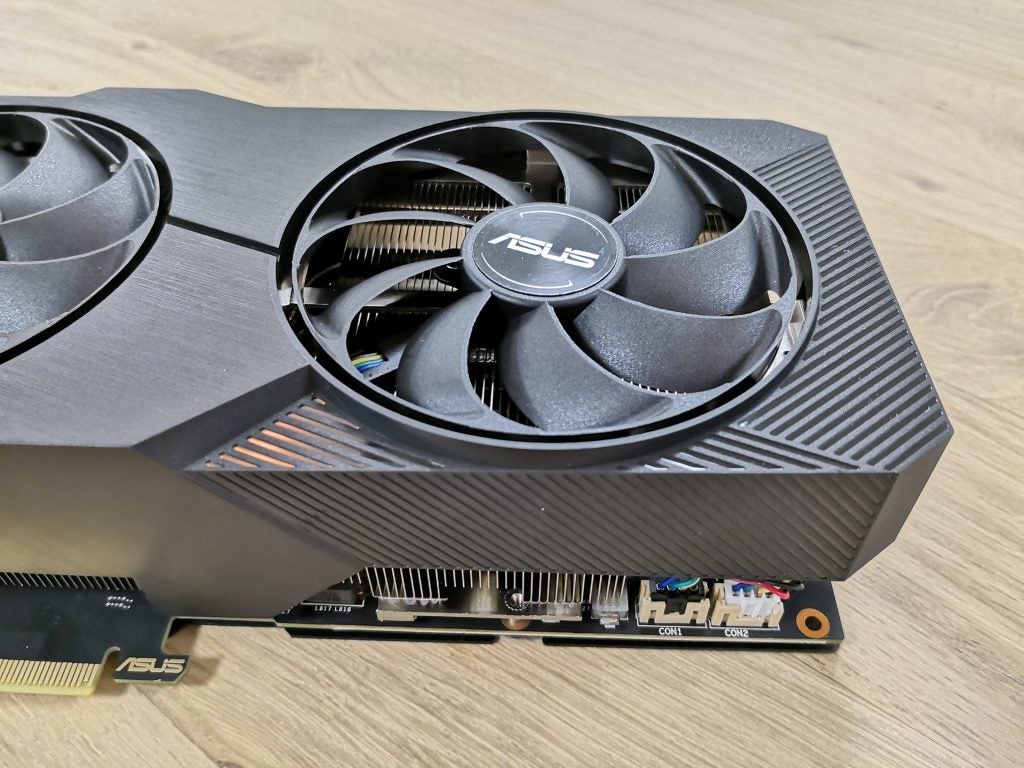
The dual-fan system ensures the Asus Dual RTX 2060 Super O8G-EVO rarely becomes concerningly hot, maximising overclocking potential
Numbers aside, what other features and specifications does the Asus RTX 2060 Super Evo OC have?
The first thing to mention is that the Asus Dual RTX 2060 Super O8G-EVO is big – it measures 267 x 118 x 58mm, and features a chunky aluminium backplate designed to help stop the primary circuit board, trace pathways and other precious components from flexing and breaking.
It has a 2.7-slot footprint, meaning that in practical terms, the Asus Dual RTX 2060 Super O8G-EVO will take up three slots on your motherboard. While it’s a big beast, Asus says its leveraged this size to pack in heatsink fins, which in theory gives you more overclocking headroom. Speaking of overclocking and cooling, the Asus Dual RTX 2060 Super O8G-EVO features two ‘axial tech’ fans, which have longer fan blades than previous designs to help keep everything cool.
Possibly inspired by a former member of the Wu-Tang Clan, Asus’s ‘0dB technology’ is also on board here – this is a feature which will see those axial fans slow to a halt when the GPU core temperature drops below 55°C, meaning things will be a little quieter during less intensive moments.
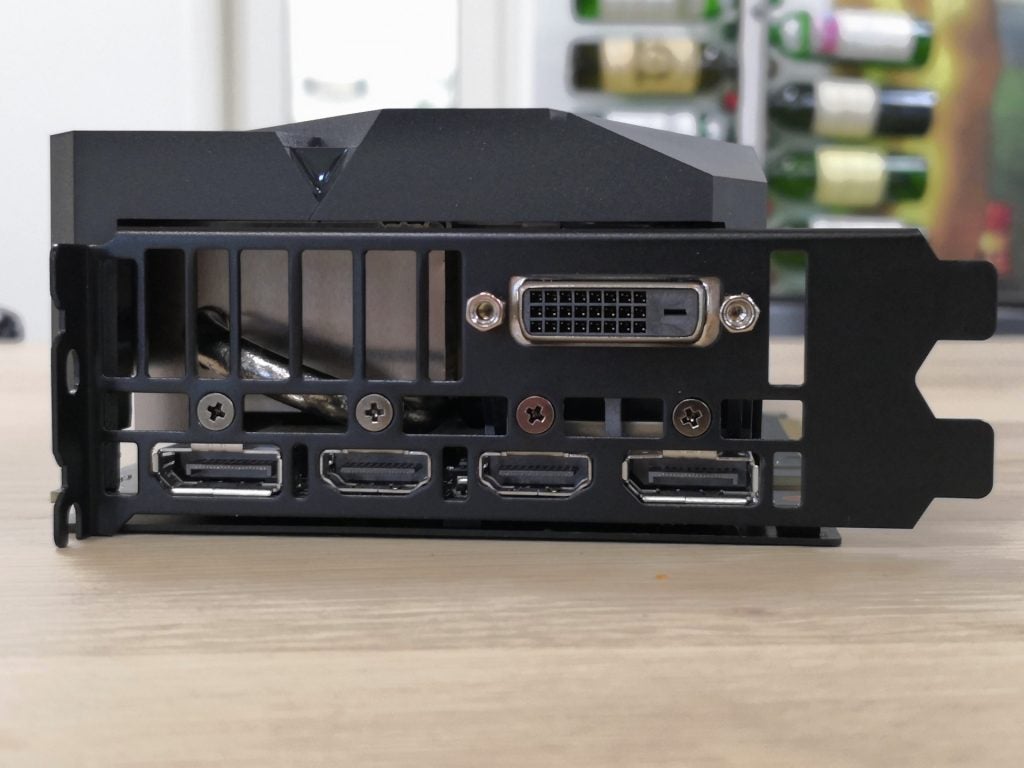
The Asus Dual RTX 2060 Super O8G-EVO lacks a USB-C port, but does feature an older DVI-D connection instead
In terms of connections, there are two HDMI 2.0b ports and two DisplayPort 1.4s on here, along with a single DVI-D port. There’s one 8-pin PCIe connection for your power needs – make sure you’ve got the right cable to hand before shelling out for this.
Aesthetically, it’s quite easy on the eye – the metal backplate gives it a chunky, hulking look, and there’s the usual Asus branding on the side, along with a diagonal coloured LED strip. At the time of writing, I wasn’t able to get this to play nicely with the Asus Aura Sync software, so I couldn’t make that light strip glow in tandem with the Corsair RAM, but that might be down to the fact we picked up this review sample ahead of release.
Related: Best gaming monitor
Asus Dual RTX 2060 Super O8G-EVO – Ray tracing and DLSS
Real-time ray tracing and the separate-but-related anti-aliasing technology DLSS (deep-learning super sampling) are two of the standout features of the entire 20 Series line of Nvidia graphics cards. But in terms of actual performance, they’re something of a mixed bag.
Real-time ray tracing more or less does what it says on the tin: it simulates, in real time, virtual light sources in game environments illuminating and reflecting off objects, sprites and other game elements in a manner designed to mimic real light sources, whether that’s fluorescent light tubes, flickering candles or the sun.
It’s a visually stunning trick, but it’s also a very computationally intensive process – to the point we saw huge frame rate drops of around 25ps on Battlefield 5 with the resolution set to Quad HD.
| DXR off | DXR on, DLSS on | DXR on, DLSS off | |
| Battlefield 5 frame rates | 80 | 65 | 55 |
Here’s where DLSS is supposed to come in. This is a feature which (provided the game you’re playing supports it and the resolution of the display you’re using is compatible) will counteract that big frame rate dip.
When activating DLSS, we saw the frame rate climb up to 65fps. That’s still not quite enough of an improvement for the performance to return to normal, but it’s still a welcome boost. The big issue here though, is that DLSS seems to slightly tarnish the visual quality of a game, with more blurred edges and less detailed textures. With ray tracing activated, you’re going to have make the tough choice to prioritize either the performance or the graphics.
There’s no doubt ray tracing looks sensational, but if you’re stoked about this then you really need to turn your attention to more powerful cards in the 20 Series – again, the RTX 2080 and RTX 2080 Ti – and pick up a big, high-resolution monitor in order to get the most out of the technology.
Even then, ray tracing is still in its early stages with just a few titles currently supporting it including Shadow of the Tomb Raider, Metro Exodus and Battlefield 5.
The pro argument for ray tracing is that support for the technology will almost definitely grow in the coming years, especially with both the Xbox Two and PS5 confirmed to be flaunting it. The likes of Cyberpunk 2077 and Watch Dogs Legion are just two examples of upcoming games confirmed to feature ray tracing, with plenty more likely to follow throughout 2020.
Related: Best motherboard
Asus Dual RTX 2060 Super O8G-EVO – Performance
The Nvidia GeForce RTX 2060 Super is – just as its moniker suggests – a specced-up version of the standard RTX 2060 graphics card. That said, its benchmark results are actually closer to the RTX 2070.
The RTX 2060 Super card has been designed to play games at a Quad HD resolution. While running games in 4K is technically possible with modern AAA titles, you’ll only be able to achieve respectable frame rates after playing around with the graphics settings. It’s a different story with games released a number of years ago though, as running Dirt Rally on the RTX 2060 Super saw the frame rate coast past 60fps with the resolution set to 4K.
Judging from the benchmark results, the closest competitor to the RTX 2060 Super is clearly the AMD Radeon RX 5700. There’s rarely much between the cards in terms of performance, but with the former boasting ray tracing and the latter being slightly cheaper, your buying decision is likely going to come down to how keen you are for realistic light rendering technology.
I tested the Asus Dual RTX 2060 Super O8G-EVO graphics card for this test, which has higher clock speeds than a Founders Edition RTX 2060 Super, so expect the benhmark results to reflect these higher specs.
Testing methodology
To ensure a fair test, I benchmarked every graphics card on the same computer rig. This means all the other components – including CPU, SSD and RAM – remained consistent throughout. Have a look at the components we used below:
Motherboard: X570 Aorus Master Gaming
Processor: AMD Ryzen 9 3900X
RAM: Corsair Vengeance 2666MHz, 16GB DDR4
PSU: Corsair CX750M
OS: Windows 10
Each game used for the benchmark testing was also carefully considered. Shadow of the Tomb Raider and The Division 2 were chosen as examples of GPU-intensive titles, with the former optimised for Nvidia drivers and the latter for AMD. Dirt Rally, meanwhile, was selected to represent games launched a number of years back and don’t demand as much GPU resources.
For every benchmark test, I picked the top graphics preset setting, while disabling features such as Vsync which can influence the frame rate based on the refresh rate of the monitor. Look below for all the results:
Shadow of the Tomb Raider
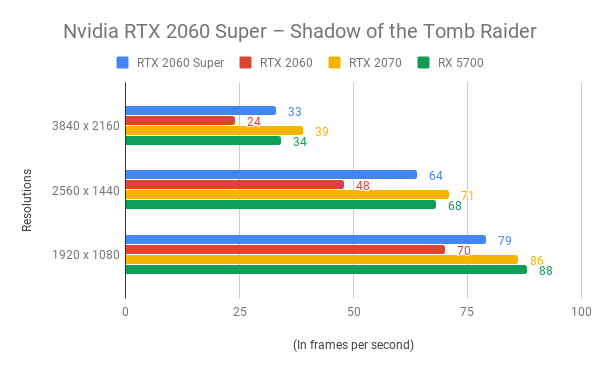
With Shadow of the Tomb Raider optimised for Nvidia cards, I expected the RTX 2060 Super to boast an advantage over AMD’s offering. In reality, the opposite happened. The RX 5700 posted superior results at every resolution despite being cheaper. That said, the difference became smaller and smaller when I dialled up the resolution and heightened the graphics settings.
But with Quad HD being the main focus for these cards, Nvidia can revel in the fact the RTX 2060 Super’s 64fps benchmark result only lagged 4fps behind the RX 5700 while also flaunting the ray tracing ace card.
The most impressive aspect of these results is how significantly they’ve improved since the standard RTX 2060, with a 16fps increase at a Quad HD resolution. With the RTX 2060 Super only costing £50 more than the standard RTX 2060, the majority of folk may well be tempted to go for a Super upgrade.
Lastly, the RTX 2060 Super saw an average 33fps score when running games in 4K. This suggests this Super card is not capable of comfortably running games in Ultra HD when playing AAA games, which comes as no surprise.
The Division 2
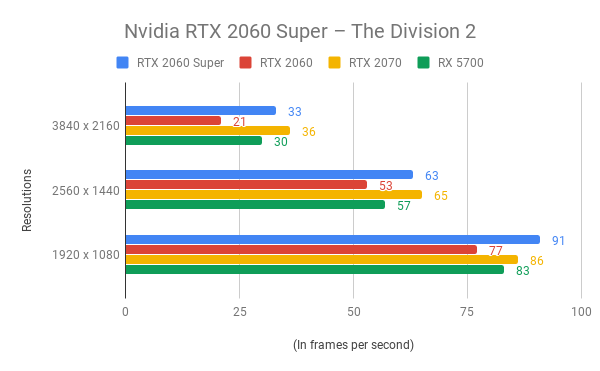
Rather bizarrely, the RTX 2060 Super graphics cards excelled with The Division 2, edging out the RX 5700 at every resolution and even saw a superior Full HD result compared to the RTX 2070. I’m not sure why this is the case, especially since The Division 2 is optimised for AMD, but it does prove the RTX 2060 Super is capable of beating the competition with select games.
The 63fps average when playing The Division 2 in Quad HD is superb, and a big contrast to the RTX 2060 which only managed 53fps. It’s only a 10fps difference, but by exceeding the 60fps mark hints the Super variant is more future-proofed for upcoming GPU-intensive games, such as Cyberpunk 2077.
Planning on playing The Division 2 in Full HD instead? The RTX 2060 Super looks to be the best card out of the four for that – with a mighty impressive 91fps score. That result outperforms the RTX 2060 by 14fps, the RX 5700 by 8fps and even the RTX 2070 by 5fps.
There’s no surprise the RTX 2060 Super isn’t suited to 4K gaming here though, as upping the resolution to this standard will see the frame rate freefall to 33fps. If you want to play modern AAA games in Ultra HD, you’re going to have to spend a lot more money.
Dirt Rally
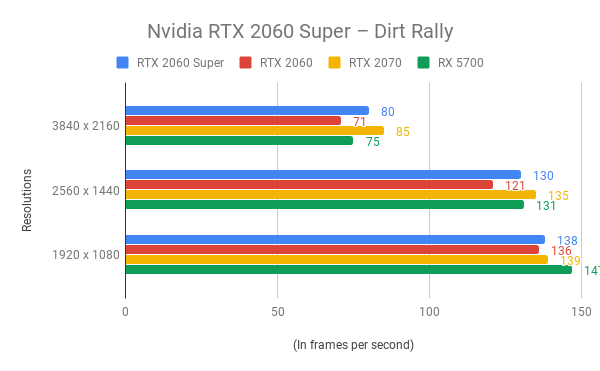
Dirt Rally emphasises how close the performance is between the RTX 2060 Super and the AMD RX 5700, with the former card taking the lead for 4K performance, and the latter regaining the advantage when scaling the resolution down to Full HD.
That said, there’s little reason to dive too deep into these differences, as all of the frame rates here are so high you’ll get an excellent and smooth performance whichever card you plump for. Plus, the difference in frame rates are so marginal you probably won’t be able to notice the difference between the two cards.
Achieving a stonking 80fps frame rate average for Dirt Rally when upping the resolution to 4K, these results suggest the RTX 2060 Super can play the majority of games released a number of years ago in Ultra HD. This doesn’t make the RTX 2060 Super a 4K graphics card, but at least you’ll get some stunning visuals when playing through your backlog of old games.
3DMark Fire Strike Ultra
The 3DMark Fire Strike Ultra benchmark software is great for testing the raw performance of a graphics card, providing a rough estimate of the GPU muscle of each graphics card. Of course, this is more of a reference than a real-time performance analysis, with in-game benchmark results offering a more realistic view on performance, but it’s still interesting nevertheless.
The benchmark score of 5265 backed up my suggestion that the RTX 2060 Super is closer in terms of performance to the RTX 2070 than the RTX 2060. It also showed how little difference in performance there is between the RTX 2060 Super and the RX 5700, despite the latter being cheaper by a fair margin.
The RTX Super at least owns the bragging rights for power consumption, as it saw a peak figure of 299.1 watts while running the Fire Strike Ultra benchmark, which undercuts the RX 5700 result of 327.6 watts. How important is this? Not really much at all, as long as your PSU can handle such requirements.
Impressively, the RTX 2060 Super (65°C) actually has a lower peak temperature than the RTX 2060 (66°C) despite the increased performance power. This is one area where the AMD Radeon RX 5000 Series has struggled, with the RX 5700 XT seeing a slightly concerning peak temperature of 80°C.
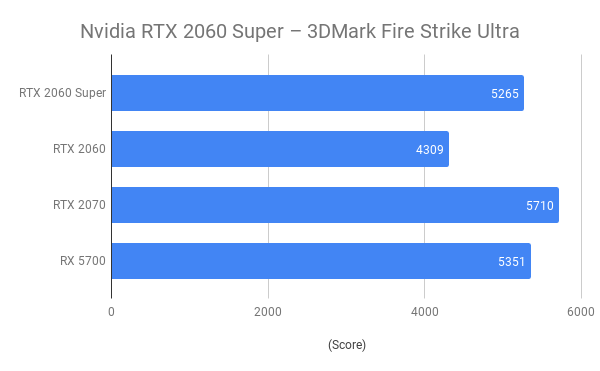
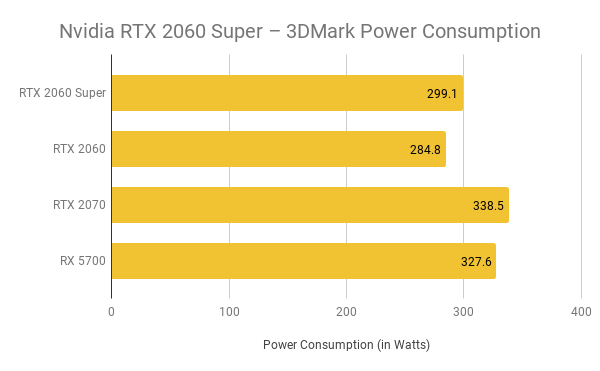
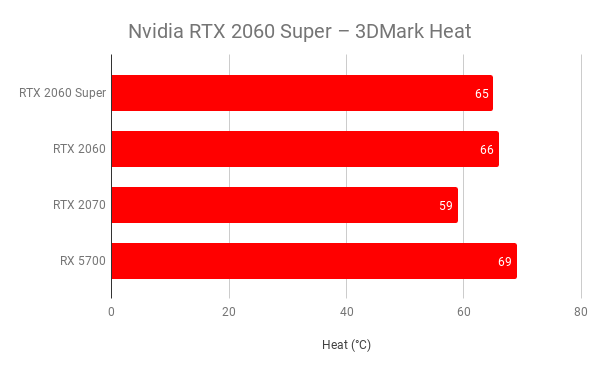
Related: Best PC games
Asus Dual RTX 2060 Super O8G-EVO – Overclocking
Aside from ray tracing support, the RTX 2060 Super has one noticeable advantage over its AMD rival and that’s the dual-fan system. This design choice means the Nvidia card is better equipped to cool down the card when things get too hot for comfort, which consequently gifts the Super card an improved overclocking performance.
While I was only able to achieve a 100MHz overclock before performance became unstable, this resulted in a 16.8 frame rate boost for the benchmark software Unigine Heaven, which is very impressive. What’s more, the temperature never exceeded 64°C during my overclocking tests, so there’s little worry of components getting roasted with the clock speeds boosted.
With such marginal performance differences between the RTX 2060 Super and the RX 5700, this overclocking potential could give Nvidia the edge in this face off, as long as you’re comfortable with fiddling around with your GPU’s settings. Bear in mind though, I’ve been testing the Asus Dual GeForce RTX 2060 Super Evo OC graphics card, which is purpose-built for overclocking, so don’t expect the same performance if you buy a Founders Edition RTX 2060 Super instead.
Should I buy the Asus Dual RTX 2060 Super O8G-EVO?
The RTX 2060 Super is a more powerful version of the already superb RTX 2060, while the Asus Dual RTX 2060 Super O8G-EVO on test here is even more specced-up than the Founders Edition RTX 2060 Super with improved clock speeds.
This is a great example of “powerful isn’t always better”, though, as the increased cost towers above the price of both the standard RTX 2060 and AMD’s RX 5700, losing the card’s bargain status in the process.
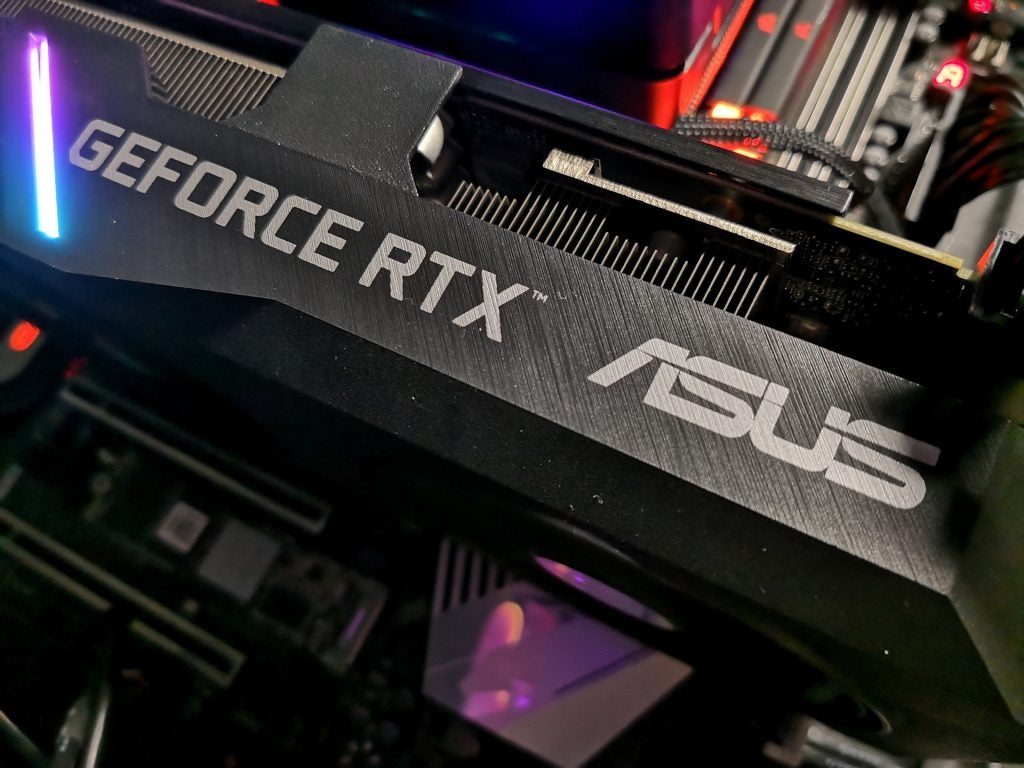
You’ll want the cheaper RTX 2060 Super Founders Edition instead of the Asus model if you’re not fussed about overclocking
Because of this price, the only legitimate reason you should choose the Asus Dual RTX 2060 Super O8G-EVO over the AMD RX 5700 is for ray tracing and overclocking potential. There’s no question that ray tracing jazzes up video game visuals with improved lighting, shadow and reflection effects, but I’m not convinced the technology is currently worth the £123 price difference.
I’d personally argue there’s not enough games that support ray tracing to make the added cost worthwhile, but you could counter that by saying it’s important to ensure your card is future proofed.
With that all said, if you have a stubborn allegiance to Nvidia you’ll still be getting a great graphics card for Quad HD gaming with the RTX 2060 Super, especially if you get this third-party Asus model which is primed for overclocking.
Verdict
If you’d rather pick up a graphics card that’s future proofed for ray tracing support instead of cheaper, all-purpose card for Quad HD gaming, then pick up an RTX 2060 Super – otherwise, you’re best off saving your money and going for a Radeon RX 5700 instead.


